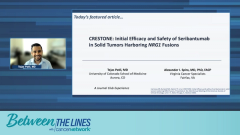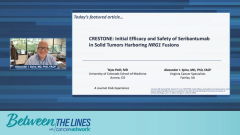
Duration of Seribantumab Therapy and Depth of Response in the CRESTONE Trial
Closing out their review of data from the CRESTONE clinical trial, expert panelists highlight the duration and depth of response with seribantumab therapy.
Episodes in this series

Transcript:
Tejas Patil, MD: This is the swimmer plot of seribantumab in tumors harboring NRG1 fusions. My sense is that this is saying the same information we saw on the waterfall plot, but are there any important observations that you have, Dr Spira, looking at this?
Alexander I. Spira, MD, PhD, FACP: We need a little more time on this. Half the graph is still less than 4 months. I’m wondering if they’ve had their second scan, even at the time of cutoff. We need a little more data. I’m encouraged by the top [of the plot]. The top 3 swimmers have a lot of laps, but as you can see, some of these are not even confirmed responses. No. 1 shows some unstable disease, but the median time here is barely a scan. Let’s see how it plays out, but I’m encouraged.
Tejas Patil, MD: Me too. These are preliminary but encouraging. Let’s see how the data mature.
This was a presentation of a patient whose baseline scans are shown on the left and week 24 scans are shown on the right. This patient achieved a partial response. A 70-year-old man with non–small cell lung cancer who has had multiple lines of therapy, including platinum-based chemotherapy, immunotherapy, and investigational therapy. [They’re] coming on fourth-line treatment with a partial response of about 35% tumor reduction at week 12, and they continue to have ongoing tumor reduction. This patient has been on treatment for over 11.5 months and it is still ongoing. This is the kind of story that’s very encouraging with seribantumab. A very heavily pretreated patient comes in, has a very nice response, and is still on therapy. My thoughts are to hopefully see more of these kinds of patients.
This is another patient, a 60-year-old woman with non–small cell lung cancer. Similar to the prior patient, she had 3 lines of systemic therapy, including platinum-based chemotherapy and immunotherapy. She had a very nice partial response with a 68% tumor reduction at week 6, and she achieved a complete response at week 24 and was ongoing for 11.7 months. These are illustrative cases of patients who’ve had a favorable response to this therapy. We’d like to see that this is true for most patients in this cohort. As we enroll more patients and the data mature, we’ll see that, but this is definitely very encouraging.
These were the conclusions that were drawn: the initial data support the ability of seribantumab to produce deep and durable benefits for patients in previously treated solid tumors harboring NRG1 fusions. In the entire cohort, the objective response was about 33%. When you focus specifically on non–small cell lung cancer, it’s about 36%. There are durable ongoing responses with the duration of response of 9.7 and 11.5 months for 2 patients. Median duration of response hasn’t been reached for the study, and the disease control rate is about 92%, which is very encouraging.
To remind listeners, this is a gene fusion for which there are no options. Historically, it hasn’t responded well to standard of care. It’s generally well tolerated and this was consistent with prior studies with seribantumab. I noted that the majority of adverse events [AEs] were grade 1 to 2. But as you pointed out, Dr Spira, as the trial matures and we start to see more real-world data, it remains to be seen whether the AEs we’re seeing in this trial—which might have been a preselection factor because these patients are fit enough to enroll in a trial—hold up. We’ll wait to see what the FDA does with this data, but they’re very encouraging. I’d like to remind viewers that NRG1 fusions are rare, so RNA-based NGS [next generation sequencing] will be important to identify these patients. What conclusions did you draw, Dr Spira, in addition to what’s been presented here?
Alexander I. Spira, MD, PhD, FACP: I have very little to add. You did a nice job. It works. You have some preliminary evidence of activity. It’s only 11 to 12 patients, so let’s not go too crazy. I’m sure there are other patients, after the data lock [is lifted], that the company knows about. I’m very encouraged. We’ll need to get the study done and find more patients and test people to get all that data in for our patients, but it’s super promising. It’s unfortunate that it’s such a low number [of patients]. It’s going to take awhile to get to the 30 to 40 or 50 patients where you feel comfortable and have a good sense of what’s going on, but we’ll get there.
Tejas Patil, MD: I agree.
Transcript edited for clarity.
Newsletter
Stay up to date on recent advances in the multidisciplinary approach to cancer.






















































































